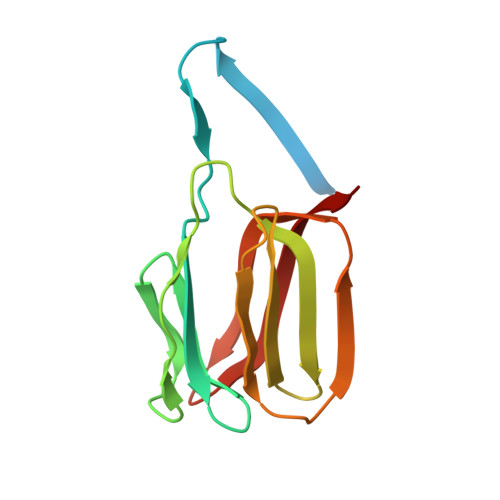C 3 -Symmetric Aromatic Core of Griffithsin Is Essential for Potent Anti-HIV Activity.
Sun, J., Zhao, G., Bylund, T., Lee, M., Adibhatla, S., Kwong, P.D., Chuang, G.Y., Rawi, R., Bewley, C.A.(2022) ACS Chem Biol 17: 1450-1459
- PubMed: 35537058
- DOI: https://doi.org/10.1021/acschembio.1c00990
- Primary Citation of Related Structures:
7RIA, 7RIB, 7RIC, 7RID, 7RKG, 7RKI - PubMed Abstract:
Lectins, carbohydrate-binding proteins of nonimmune origin, bind to carbohydrates and glycan shields present on the surfaces of cells and viral spike proteins. Lectins thus hold great promise as therapeutic and diagnostic proteins, exemplified by their potent antiviral activities and the desire to engineer synthetic carbohydrate receptors based on lectin recognition principles. Here, we describe a new carbohydrate-binding architectural motif©¤namely, a C 3 -symmetric tyrosine-based aromatic core, present in the therapeutic lectin griffithsin (GRFT). By using structure-based amino acid substitutions, X-ray crystallography, molecular dynamics (MD) simulations, and HIV-1 neutralization assays, we show that this core is critical for potent (pM) antiviral activity and nanomolar binding to the glycan shield largely consisting of high mannose glycans. Crystal structures and MD simulations show that CH-¦Ğ interactions stabilize the aromatic cluster to maintain the three pseudo-symmetric carbohydrate-binding sites, nonaromatic amino acid substitutions (Tyr to Ala) abrogate antiviral activity, and increasing the aromatic CH-¦Ğ edge-to-centroid interface via a Tyr to Trp substitution yields a GRFT variant with improved potency and increased residence time of Man-9 observed in MD simulations. NMR titrations of a Tyr-to-Ala variant indicate that disruption of the aromatic prevents the intermolecular crosslinking between two equivalents of Man-9 and one carbohydrate-binding face observed in wild-type GRFT and known to be critical for picomolar potency of this lectin. This C 3 -symmetric aromatic core defines a new recognition motif for the design of carbohydrate receptors and suggests principles for engineering known lectins to have increased affinity and stability.
Organizational Affiliation:
Laboratory of Bioorganic Chemistry, National Institute of Diabetes and Digestive and Kidney Diseases, National Institutes of Health, Bethesda, Maryland 20892, United States.
















